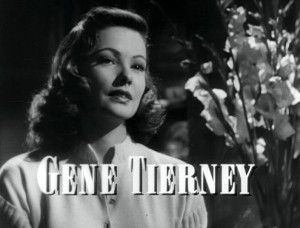Laura/ 1944/ Twentieth Century Fox/88 min.
“Laura” makes me nostalgic for a life I never led — the adventures of a 1940s career girl living in Manhattan: landing a job on Madison Avenue, buying suits and silk stockings for work, renting a place for $40/month, meeting handsome men, dinner and drinks at the Stork Club, weekend trips to the country.
 Of course, “Laura” does have a few downsides — murder and mistaken identity, for starters. Seems that turning every head and being the toast of the town, as is the case with the charming and lovely Laura (Gene Tierney), may prove very dangerous. In a series of flashbacks, we learn the details of Laura’s life and it appears that in addition to having many admirers, she attracted an enemy or two as well.
Of course, “Laura” does have a few downsides — murder and mistaken identity, for starters. Seems that turning every head and being the toast of the town, as is the case with the charming and lovely Laura (Gene Tierney), may prove very dangerous. In a series of flashbacks, we learn the details of Laura’s life and it appears that in addition to having many admirers, she attracted an enemy or two as well.
The movie starts with Waldo Lydecker (Clifton Webb) setting the scene. Lydecker, a campy, sybaritic writer, played mentor to Laura as she made a name for herself in advertising and he’s extremely proud of his protegee’s success, especially her popularity with men.
Lydecker is also, quite rightly, very proud of his apartment, with its animal-print chairs and a chunky bathtub equipped with a swiveled tray for his Smith Corona typewriter. I love this Lydecker line: “In my case, self-absorption is completely justified. I have never discovered any other subject quite so worthy of my attention.”
Later, he tells Laura, “For you, a lean, strong body is the measure of a man.” I knew I liked Laura. That doesn’t mean she’s picked the right man, however. She’s engaged to smarmy, sleazy Shelby (Vincent Price) and he clearly doesn’t deserve her.
Once the murder (I’ll keep this a bit vague so I don’t spoil it) is committed, we meet the anti-society, take-no-guff Det. Lt. Mark McPherson (Dana Andrews), who questions the upper-crust types that populate Laura’s world. Mark may lack social graces but he’s definitely a lean, strong body worth rooting for. And Mark definitely falls for Laura.
Amid his investigation, there’s plenty of cocktail conversation, pretentious accents, gorgeous gowns and quirky personalities. And after realizing Murder No. 1 was a bit careless, the killer strikes again.
Beautifully put together and immensely entertaining, “Laura” was nominated for five Academy Awards – art direction, screenplay, director, supporting actor (Webb) and b&w cinematography. Joseph LaShelle won for cinematography.
Based on a popular novel by Vera Caspary, the screenplay by Jay Dratler, Samuel Hoffenstein and Betty Reinhardt, with uncredited help from Ring Lardner Jr., is full of wit and Algonquin-caliber one liners. The wonderfully lush music came from David Raksin.
Otto Preminger served as producer and took over as director after Fox chief Darryl Zanuck pulled Rouben Mamoulian off the job. Preminger replaced the original cinematographer Lucien Ballard with LaShelle.
In 1977, the New Yorker called the movie: “Everybody’s favorite chic murder mystery.” This is no B picture. But that’s not to say it doesn’t have a dark side. With its treatment of sexual obsession, casual betrayal and class structure, “Laura” explores raw themes in a refined setting.
One of noir’s great strengths is that as a genre it very frankly challenged the myth that America was a classless society and pointed out that patrician elegance bred corruption just as much as, if not more than, the streetwise desperation of common criminals.
Most memorable in “Laura” are the rich and varied characters brought to life by Tierney, Webb, Andrews, the inimitable Price, Judith Anderson and the rest of the cast. When the film was released, Andrews and Tierney in particular seemed to have the world on a string, but sadly not for very long.
Andrews went on to star in William Wyler’s “The Best Years of Our Lives” (1946), which snared the Oscar for best picture and was the biggest box-office hit of the 1940s. Andrews also made some more classic noirs, such as Preminger’s “Fallen Angel” and “Where the Sidewalk Ends,” and Fritz Lang’s “While the City Sleeps.” But he had only middling success after the early 1950s. Afflicted with alcoholism, he eventually overcame addiction and worked to increase public awareness of the disease.
Tierney’s star burned a bit brighter before fading — she starred in the Oscar-nominated color noir “Leave Her to Heaven” (1945), “The Ghost and Mrs. Muir” (1947) and “Night and the City” (1950), a key b&w noir. Despite her looks, talent and success as an actress, she suffered from mental illness and endured a great deal of pain in her personal life, including a difficult marriage to Oleg Cassini and an affair with John F. Kennedy.
She refused to give up on her career however and she did land roles in good films, such as 1962’s “Advise and Consent” (also by Preminger). On a happy note, she eventually settled down with a rich Texan (the ex-husband of actress Hedy Lamarr).
But before all that there was “Laura,” a lovely snapshot of a vanished world and a fabulous way to while away a winter evening.










From FNB readers